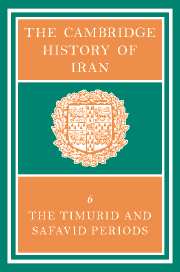Book contents
- Frontmatter
- 1 THE JALAYIRIDS, MUZAFFARIDS AND SARBADĀRS
- 2 TĪMŪR IN IRAN
- 3 THE SUCCESSORS OF TĪMŪR
- 4 THE TÜRKMEN DYNASTIES
- 5 THE SAFAVID PERIOD
- 6 THE SAFAVID ADMINISTRATIVE SYSTEM
- 7 EUROPEAN CONTACTS WITH PERSIA, 1350–1736
- 8 TRADE FROM THE MID-14TH CENTURY TO THE END OF THE SAFAVID PERIOD
- 9 SOCIAL AND INTERNAL ECONOMIC AFFAIRS
- 10 THE EXACT SCIENCES IN TIMURID IRAN
- 11 PERSIAN SCIENCE IN SAFAVID TIMES
- 12 RELIGION IN THE TIMURID AND SAFAVID PERIODS
- 13 SPIRITUAL MOVEMENTS, PHILOSOPHY AND THEOLOGY IN THE SAFAVID PERIOD
- 14 CARPETS AND TEXTILES
- 15 (a) TIMURID ARCHITECTURE
- (b) SAFAVID ARCHITECTURE
- 16 (a) THE PICTORIAL ARTS IN THE TIMURID PERIOD
- (b) THE ARTS IN THE SAFAVID PERIOD
- 17 (a) PERSIAN LITERATURE IN THE TIMURID AND TÜRKMEN PERIODS (782–907/1380–1501)
- (b) HĀFIZ AND HIS CONTEMPORARIES
- (c) PERSIAN LITERATURE IN THE SAFAVID PERIOD
- 18 PERSIAN POETRY IN THE TIMURID AND SAFAVID PERIODS
- Bibliographies
- Plate section
- Plate section
- Plate section
- Maps
- References
18 - PERSIAN POETRY IN THE TIMURID AND SAFAVID PERIODS
Published online by Cambridge University Press: 28 March 2008
- Frontmatter
- 1 THE JALAYIRIDS, MUZAFFARIDS AND SARBADĀRS
- 2 TĪMŪR IN IRAN
- 3 THE SUCCESSORS OF TĪMŪR
- 4 THE TÜRKMEN DYNASTIES
- 5 THE SAFAVID PERIOD
- 6 THE SAFAVID ADMINISTRATIVE SYSTEM
- 7 EUROPEAN CONTACTS WITH PERSIA, 1350–1736
- 8 TRADE FROM THE MID-14TH CENTURY TO THE END OF THE SAFAVID PERIOD
- 9 SOCIAL AND INTERNAL ECONOMIC AFFAIRS
- 10 THE EXACT SCIENCES IN TIMURID IRAN
- 11 PERSIAN SCIENCE IN SAFAVID TIMES
- 12 RELIGION IN THE TIMURID AND SAFAVID PERIODS
- 13 SPIRITUAL MOVEMENTS, PHILOSOPHY AND THEOLOGY IN THE SAFAVID PERIOD
- 14 CARPETS AND TEXTILES
- 15 (a) TIMURID ARCHITECTURE
- (b) SAFAVID ARCHITECTURE
- 16 (a) THE PICTORIAL ARTS IN THE TIMURID PERIOD
- (b) THE ARTS IN THE SAFAVID PERIOD
- 17 (a) PERSIAN LITERATURE IN THE TIMURID AND TÜRKMEN PERIODS (782–907/1380–1501)
- (b) HĀFIZ AND HIS CONTEMPORARIES
- (c) PERSIAN LITERATURE IN THE SAFAVID PERIOD
- 18 PERSIAN POETRY IN THE TIMURID AND SAFAVID PERIODS
- Bibliographies
- Plate section
- Plate section
- Plate section
- Maps
- References
Summary
Politically, this period extended from the death of the last great Īl–Khān (736/1335) to the accession of Nādir Shāh (1148–60/1736–47). It encompassed the rise and fall of two powerful dynasties, the Timurids (771–911/1370–1506) and the Safavids (907–1135/1501–1722), as well as of a number of lesser houses.
From a purely literary standpoint the era falls into two phases. The first, comprising roughly a century, was a turbulent period of wars, struggle for power, and widespread destruction, culminating in the sweeping conquests of Tīmūr and ending with his death in 807/1405. Its literature is best considered a continuation of that of the previous period, which witnessed the ascendancy of lyrico-mystical poetry (the 'Irāqī school). Beginning in the 12th century, this style reached its zenith with Hāfiz in the 14th.
The second phase, stretching from the 15th to about the middle of the 18th century, may be said to have begun with the succession of Tīmūr's son Shāh Rukh in 807/1405 and his long and relatively peaceful reign, and continued to the fall of the Safavids and the rise of Nādir Shāh. What marks the division between the two phases is the emergence of a new school, whose style is called the Indian style. This school, which had its origins in the Timurid period, produced a great deal of Persian poetry, not only in Persia, but also in adjacent countries – Ottoman Turkey, Iraq, Central Asia, Afghanistan, and especially India. The appeal of this style continued for Persian poets in these lands long after it had lost impetus in Persia.
- Type
- Chapter
- Information
- The Cambridge History of Iran , pp. 965 - 994Publisher: Cambridge University PressPrint publication year: 1986
References
- 2
- Cited by

